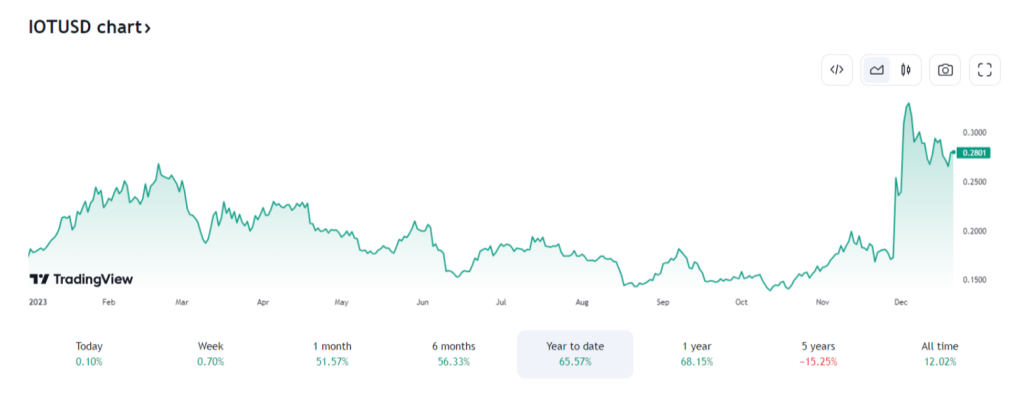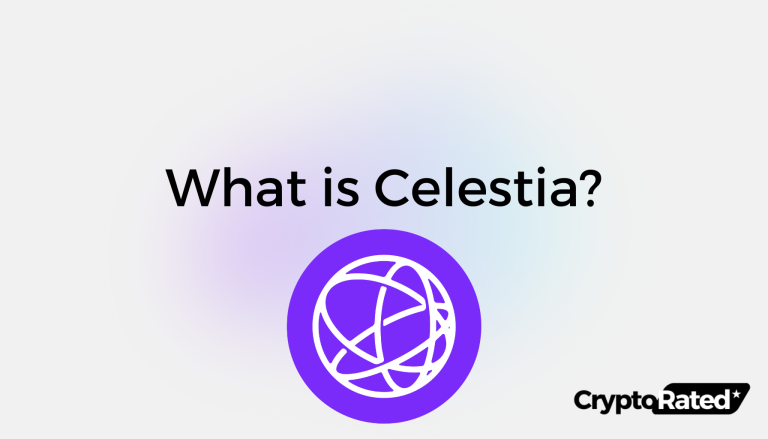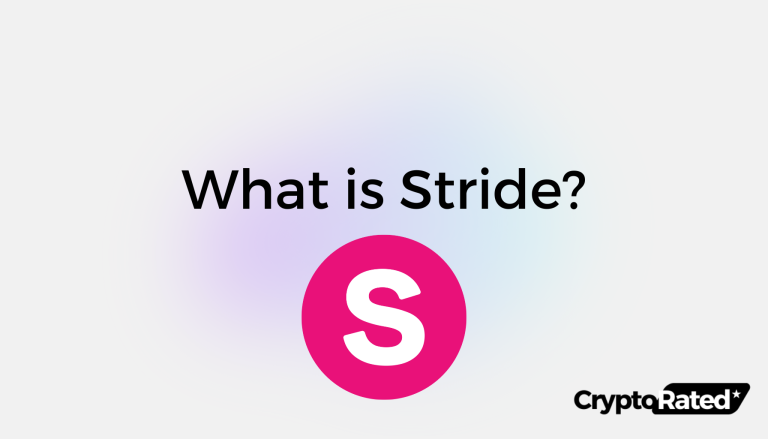
What Is IOTA?
IOTA is a distributed ledger designed to facilitate transactions between devices in the Internet of Things (IoT) ecosystem. The ledger uses IOTA, a cryptocurrency, to account for transactions in its network. IOTA’s key innovation is Tangle, a system of nodes used for confirming transactions. Tangle is claimed to be faster and more efficient than most other layer-1 blockchains offering transactions that are essentially free.
Key Takeaways
- IOTA is a distributed ledger developed to handle transactions between connected devices in the IoT ecosystem.
- Tangle is IOTA’s solution to scalability and performance issues with Bitcoin. It replaces Bitcoin’s blockchain with a system of nodes in which each new transaction confirms two previous transactions.
- IOTA transactions are ideal for micro-transactions due to their low fees and speed.
What Is The History Of IOTA?
IOTA’s story begins in 2015, born from the vision of four individuals: David Sønstebø, Dominik Schiener, Sergey Ivancheglo, and Serguei Popov1. They wanted to create a new kind of cryptocurrency tailored to the Internet of Things (IoT). They named it Iota, after the Greek alphabet’s smallest letter, symbolizing a lightweight solution for a massive network.
Initially funded through a crowd sale, IOTA launched in 2016 with a unique twist: no blockchain. Instead, it utilizes a “Tangle”, where each transaction validates two others, creating a web of interconnected data2. This eliminates the energy-intensive mining of traditional blockchains, making Iota ideal for micro-transactions in the resource-constrained world of the IoT.
While not without its challenges, Iota has attracted attention for its potential to revolutionize secure data exchange between billions of connected devices. In 2017, a dedicated foundation was established to foster its development and adoption.
IOTA’s story doesn’t end in 2017. 2022 and 2023 have been pivotal years for the project, marked by significant technical progress and ecosystem growth.
2022:
- Shimmer network: A dedicated testnet launched, allowing developers to safely build and experiment with IOTA 2.0 features before deploying on the mainnet.
- IOTA Streams: Debut of a data-sharing protocol enabling secure, real-time communication between devices on the IOTA network.
- Community Treasury: A decentralized fund established to support ecosystem development, governed directly by IOTA token holders.
2023:
- IOTA 2.0: Significant strides were made towards this major protocol upgrade, featuring a Proof-of-Authority consensus mechanism and laying the groundwork for increased scalability and interoperability3.
- EVM (Ethereum Virtual Machine) Chain Launch: A planned milestone for late 2023, enabling smart contracts and dApp development on the IOTA network, further boosting its capabilities.
- Governance Framework: Progress continues on establishing a robust governance system for the IOTA community, empowering token holders to actively shape the project’s future.
How Does IOTA Work?
Unlike blockchains, IOTA operates on a unique structure called the “Tangle.” Imagine a web of transactions where each new one validates two existing ones, weaving them together. This eliminates the need for miners and energy-intensive mining, paving the way for feeless micro-transactions4.
Here’s the breakdown:
Consensus System: Called “Coordicide,” it currently features a central coordinator node run by the IOTA Foundation. This ensures initial network stability while IOTA 2.0, with a decentralized Proof-of-Authority consensus, is being developed5.
Ledger: Instead of linear blocks, the Tangle forms a directed acyclic graph. This dynamic network adapts to transaction volume, avoiding congestion and enhancing scalability compared to traditional blockchains.
Crypto: The native token, MIOTA, serves as the unit of value and data carrier on the network. Its feeless nature makes it ideal for micro-transactions between devices in the Internet of Things (IoT).
Other key features:
- Lightweight: Efficient enough for resource-constrained IoT devices to participate.
- Secure: Cryptographically protected against double-spending and manipulation.
- Scalable: Designed to handle massive transaction volumes as the IoT expands.
While still in development, IOTA’s innovative approach presents a potential solution for secure and efficient data exchange in the age of interconnected devices. Its future hinges on the successful implementation of IOTA 2.0 and continued community support.
What Are Some Of The Limitations of IOTA?
IOTA has faced criticism regarding its technical flaws and vulnerabilities. One of the most significant concerns was a phishing attack on its network that resulted in the theft of IOTA worth $3.94 million6. The IOTA development team responded by writing a blog post outlining steps to generate a strong seed for using its cryptocurrency.
IOTA’s developers created their encryption method from scratch, forgoing the widely-used SHA-256 hash function used in Bitcoin. However, the team at MIT’s Digital Currency Initiative found serious vulnerabilities with IOTA’s hash function, called Curl. The function produced the same output when given two different inputs, which is known as collision and denotes a broken hash function.
As of 2020, IOTA’s network used a central server known as a Coordinator to ensure transaction security. However, this practice diluted its claims of being a decentralized system since the introduction of a Coordinator resulted in the introduction of a single point of failure. It also slowed down the network’s speed because parallel processing does not occur in a Coordinator-based system.
What Are The Tokenomics Of IOTA (IOTA)?
IOTA has a maximum supply of 4.6 billion, of which just over 3 billion coins are already in circulation as of December 2023. According to CoinGeckon7, the crypto has a market capitalization of $862 million, ranking it well within the top 100 cryptos. It trades for $0.28 which is a 95% discount from its all-time high of $5.25.

How Has IOTA (IOTA) Traded In 2023, And What Is The IOTA Price Prediction?
IOTA has returned just under 70% in the last year, partly thanks to a massive spike in early December. TradingView data shows that it traded fairly flat for most of the year even though the broader market was rallying8.
Coincodex9 has issued a mixed forecast for IOTA. Their price target for 2024 ranges from $0.28 to $0.64.They don’t expect it to trade above $1 within this decade, which suggests a new all-time is off the cards.
Changelly is fairly bullish on IOTA. They expect the crypto to rally by over 40% in the first half of 2024 and possibly reach $0.5 in 2025 or 2026. They also don’t foresee a new all-time high in the near future.
Remember that crypto prices are extremely volatile, and you should always do your own research before risking your capital. Nothing in this post should be considered as financial advice.

Final Thoughts on IOTA
IOTA presents an alternative system to the standard public blockchain with its Tangle ledger. The project has shown that micro-transactions can be feasible thanks to the technology that allows IOTA users to execute transactions that are essentially 100% free. Despite the impressive tech, the project has been limited by hacks and low adoption rates, which partly explains why the IOTA coin has failed to keep up with other layer-1s.
Frequently Asked Questions
What Is IOTA?
IOTA is a feeless cryptocurrency designed for the Internet of Things (IoT). It ditches blockchains for a unique “Tangle” structure, enabling tiny transactions between devices without energy-guzzling mining. This opens doors for micropayments, secure data sharing, and smart contracts in the ever-connected world of the IoT.
Where Can You Buy IOTA?
What is the Primary Purpose of IOTA?
IOTA is a distributed ledger technology that aims to provide a secure and scalable platform for the Internet of Things (IoT) devices. It was designed to enable feeless and instant transactions between machines and humans. Unlike traditional blockchain technology, IOTA uses a directed acyclic graph (DAG) called the Tangle, which allows for parallel transactions and eliminates the need for miners to validate transactions.
How Does IOTA’s Tangle Technology Differ from Traditional Blockchain?
IOTA’s Tangle technology differs from traditional blockchain in several ways. First, it uses a DAG instead of a linear chain, which allows for parallel processing of transactions. Second, it eliminates the need for miners to validate transactions, making it more energy-efficient and scalable. Third, IOTA’s Tangle technology allows for free transactions, making it ideal for microtransactions.
WRITTEN
Peter Barker
Peter is an experienced crypto content writer and a DeFi enthusiast with more than 3+ years of experience in the space. Previously a journalist and news editor at a leading European news sourcing agency.




